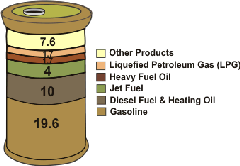In 2008, petroleum consumption in the U.S. averaged 19.498 million barrels per day. The good news is that the consumption rate in 2008 was down almost a million barrels per day relative to 2007, but the bad news is that our current consumption rate, oil discoveries with the potential to yield 15 billion barrels of petroleum represent just over a two-year supply. Of course, a slower consumption rate would make the supply last longer, but even that approach is as much of a short-term solution as is the discovery of new reserves.
Ever wonder why only 70% of each barrel of petroleum is used for transportation fuels? The truth is that 70% is about what we’re limi ted to. You see, during the refining process, the different petroleum fuel types separate out by the weights of their carbon chains (which is also what determines their energy content). As seen in the figure of petroleum products (gal) per barrel, gasoline comprises about 43% of each barrel, diesel 20.6% and jet fuel 8.5%, all of which collectively comprise the bulk of petroleum-based transportation fuels (although some residual fuel is also burned in oceanic container ships).
ted to. You see, during the refining process, the different petroleum fuel types separate out by the weights of their carbon chains (which is also what determines their energy content). As seen in the figure of petroleum products (gal) per barrel, gasoline comprises about 43% of each barrel, diesel 20.6% and jet fuel 8.5%, all of which collectively comprise the bulk of petroleum-based transportation fuels (although some residual fuel is also burned in oceanic container ships).
Petroleum-based transportation fuels are incredibly energy-rich, with 124,000 (gasoline) to 139,000 (diesel) BTU’s per gallon! The energy content in the food we eat is measured in calories (technically kilocalories) and one food calorie is the equivalent of 3.9683 BTU’s; thus, it can be said that one gallon of gasoline has the food energy equivalent of 31,247.6 food calories! I once saw a news story about a swimmer who needed a 15,000 food calorie fuel tank to swim across the English Channel. If he’d traveled instead by boat with an engine as efficient as the human body at converting chemical energy into mechanical energy, he’d only need a half tank of gasoline!
Unfortunately, despite all of its feats, human engineering is not nearly as impressive as the human body when it comes to metabolizing energy. As noted on the Department of Energy’s Fuel Economy website, “Only about 15% of the energy from the fuel you put in your tank gets used to move your car down the road or run useful accessories…Therefore, the potential to improve fuel efficiency with advanced technologies is enormous.”
But like all things fossil, improved efficiency is only a short-term solution. However, because the other 30% of every refined barrel of oil is used directly (as an ingredient) or indirectly (provides machinery energy) in the manufacturing of products, we might as well make the most efficient use of the other 70% of each barrel so long as we’re going to need the 30% associated with manufacturing. Before the internal combustion engine created a need for gasoline, it was a discarded waste product in the refinement of petroleum to produce kerosene. But today, dumping perfectly good gasoline is hardly responsible.
So until a 100% efficient engine is designed and until we don’t need petroleum for any aspect of our society, here’s how to make transportation fuels go further:
-
If you don’t need to drive, don’t drive! Make a conscientious effort to consolidate trips. Carpool or take public transportation when possible. Even if you just make the effort once per week, the collective savings are appreciable.
-
Keep up with car maintenance, keep tires properly tire inflated and remove unnecessary weight from the vehicle to increase fuel efficiency.
-
Modify driving habits and/or routes driven to increase the frequency of smoother accelerations and decelerations instead of revving up the engine, hitting the brakes and excessive engine idling.
-
If a situation requires engine idling for extended periods, turn off the engine when doing so will not create an unsafe situation.
-
Most gasoline at the pump now contains 10% ethanol, which means that gasoline supplies will last 10% longer. However, because a gallon of ethanol has about 28% of the energy potential of a gallon of gasoline, a reduction in overall miles per gallon of 2.8% should be expected for every 10 gallons of fuel added to the vehicle. The jury is also still out as to the whether the processes of making and transporting ethanol is more energy-intensive than gasoline.
-
The loss (about 7%) in energy potential with vegetable-based biodiesel is not nearly as severe as with ethanol, but like ethanol the jury is still deliberating about the energy requirements for biodiesel vs. petrodiesel.
-
Given #5 and #6 above and the adage about investing eggs in multiple baskets, it is probably more beneficial for society if everybody does a little (i.e., 10% ethanol blends and bio-diesel blends across the board) than if a few people do a lot (i.e., a handful of people drive pure ethanol or pure bio-diesel vehicles) so that the petroleum fuel savings is spread out over a diversity of driving conditions rather than just among conscientious drivers.
-
When it is time to replace your current vehicle, replace it with a vehicle that is as fuel-efficient as possible given the driving conditions that it is needed for. While fuel-efficiency may not be as important as safety ratings, it should at least be more important than ‘how the car makes you feel’.
Back to Energy main page
